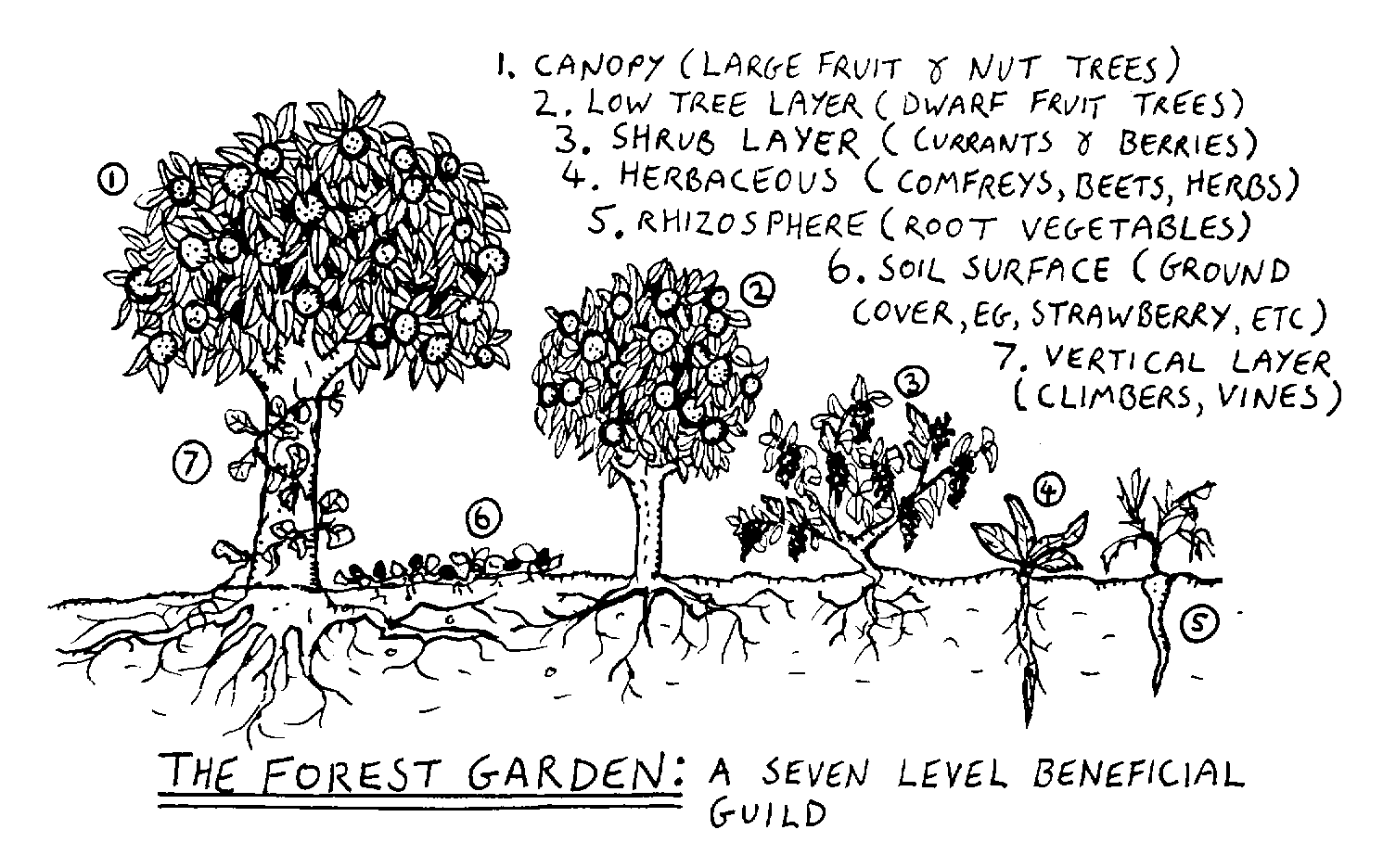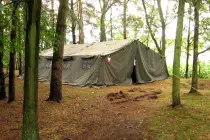from dseelman:
I have been thinking a lot about planting some food in the woods lately. I listened to http://www.thesurvivalpodcast.com/guerrilla-gardeing-for-survival a few weeks ago and started wondering what I could do. Some of this area is zone 4 and some zone 5. Anyone have any thoughts?
Tuesday, June 29, 2010
Wednesday, June 23, 2010
Tuesday, June 22, 2010
The Revolution is You - The Survival Podcast Anthem
Congrats to http://thesurvivalpodcast.com for their two year anniversary! Thanks for your service Jack.
Wednesday, June 16, 2010
Quik Clot
from: http://get-urban-survival-skills.blogspot.com/2010/05/urban-survival-essential-medical-item.html
Urban Survival Essential Medical Item – Quik Clot
Z-Medica offers the QuikClot brand products which are sponge type bandages or gauze, composed of an inert mineral substance-hemostatic agent that rapidly stops even severe bleeding. The ability to stop bleeding is essential for the Urban Survivor when medical services are greatly reduced or non-existent.
The Company decribes QuikClot as a hemostatic agent ins a molecular sieve, sifting molecules by size. When QuikClot comes into contact with blood in and around a wound, it rapidly takes in the smaller water molecules from the blood. The larger platelet and clotting factor molecules remain in the wound in a highly concentrated form. This promotes extremely rapid natural clotting and prevents severe blood loss. Additionally, the engineered particles provide key surface chemistry, rapidly enhancing the body's natural coagulation process. Z-Medica claims this process represents a new approach to hemostasis, which typically involves adding clotting factors rather than extracting elements to halt bleeding
In service with the military, law enforcement and emergency medical providers, QuikClot is a giant step forward in the ability to treat trauma involving potential life threatening blood loss.
QuikClot Combat Gauze provides the ultimate in stopping power for traumatic wounds; requiring no mixing, measuring or heat - just open and apply,. Easy to pack, it stays cool under pressure and remains ultra flexible while conforming to any shape or size wound, and removes easily without effect.
QuikClot 1st Response is the latest Z-Medica product for first responders, environmental health & safety teams and industrial nurses. It is the same proven technology developed for the military, packaged for convenient use by first responders, to help save lives right at the scene of accidents, crimes, fires and other emergencies. As in the latest product for the military, QuikClot 1st Response has been re-engineered to remain cooler on contact. It has a greatly reduced exothermic reaction, with maximum temperatures in vivo typically at 105 degrees F.
QuikClot 1st Response is easy to use. Just rip open a packet, pack the self-contained sponge into the wound and the bleeding stops rapidly. For larger wounds, use more than one sponge. The sponges will conform to the shape of the wound. QuikClot 1st Response is easily removed in the hospital setting.
QuikClot 1st Response comes in a box that contains five individually packaged .875-ounce (25g) hemostatic sponges – quantities sufficient to address most situations encountered by first responders.
QuikClot ACS+ is the latest Z-Medica product. QuikClot ACS+ is offered in a delivery system similar to the original QuikClot ACS and allows the same ease of application and removal. As a result of intensive research and development, the formulation of QuikClot ACS+ has been re-engineered to stay cooler on contact. It has a greatly reduced exothermic reaction, with maximum temperatures in vivo typically at 105 degrees F. This cooler formulation was developed in conjunction with the U.S. Marines, with applications beyond the military.
When dealing with large, severe injuries on the battlefield or here at home, a few seconds can mean the difference between losing a limb – or losing a life. When time is critical, just rip open a packet of QuikClot ACS+, pack the self-contained sponge into the wound and the bleeding stops rapidly. The sponge can be packed to conform to the shape of the wound and is easily removed in the hospital setting.
Each package of QuikClot ACS+ contains one 3.5-ounce (100g) hemostatic sponge. It is also available in a Z-Medica TraumaPak, along with a pressure bandage and high volume gauze.
Urban Man has several personal medical kits as well as a large team medical kit that contains all three QuikClot products mentioned above.
The Company decribes QuikClot as a hemostatic agent ins a molecular sieve, sifting molecules by size. When QuikClot comes into contact with blood in and around a wound, it rapidly takes in the smaller water molecules from the blood. The larger platelet and clotting factor molecules remain in the wound in a highly concentrated form. This promotes extremely rapid natural clotting and prevents severe blood loss. Additionally, the engineered particles provide key surface chemistry, rapidly enhancing the body's natural coagulation process. Z-Medica claims this process represents a new approach to hemostasis, which typically involves adding clotting factors rather than extracting elements to halt bleeding
In service with the military, law enforcement and emergency medical providers, QuikClot is a giant step forward in the ability to treat trauma involving potential life threatening blood loss.
QuikClot Combat Gauze provides the ultimate in stopping power for traumatic wounds; requiring no mixing, measuring or heat - just open and apply,. Easy to pack, it stays cool under pressure and remains ultra flexible while conforming to any shape or size wound, and removes easily without effect.
QuikClot 1st Response is the latest Z-Medica product for first responders, environmental health & safety teams and industrial nurses. It is the same proven technology developed for the military, packaged for convenient use by first responders, to help save lives right at the scene of accidents, crimes, fires and other emergencies. As in the latest product for the military, QuikClot 1st Response has been re-engineered to remain cooler on contact. It has a greatly reduced exothermic reaction, with maximum temperatures in vivo typically at 105 degrees F.
QuikClot 1st Response is easy to use. Just rip open a packet, pack the self-contained sponge into the wound and the bleeding stops rapidly. For larger wounds, use more than one sponge. The sponges will conform to the shape of the wound. QuikClot 1st Response is easily removed in the hospital setting.
QuikClot 1st Response comes in a box that contains five individually packaged .875-ounce (25g) hemostatic sponges – quantities sufficient to address most situations encountered by first responders.
QuikClot ACS+ is the latest Z-Medica product. QuikClot ACS+ is offered in a delivery system similar to the original QuikClot ACS and allows the same ease of application and removal. As a result of intensive research and development, the formulation of QuikClot ACS+ has been re-engineered to stay cooler on contact. It has a greatly reduced exothermic reaction, with maximum temperatures in vivo typically at 105 degrees F. This cooler formulation was developed in conjunction with the U.S. Marines, with applications beyond the military.
When dealing with large, severe injuries on the battlefield or here at home, a few seconds can mean the difference between losing a limb – or losing a life. When time is critical, just rip open a packet of QuikClot ACS+, pack the self-contained sponge into the wound and the bleeding stops rapidly. The sponge can be packed to conform to the shape of the wound and is easily removed in the hospital setting.
Each package of QuikClot ACS+ contains one 3.5-ounce (100g) hemostatic sponge. It is also available in a Z-Medica TraumaPak, along with a pressure bandage and high volume gauze.
Urban Man has several personal medical kits as well as a large team medical kit that contains all three QuikClot products mentioned above.
Long Term Food Storage Options
Episode 93 – Long Term Food Storage Options
By Todays Survival Show on June 1st, 2010
Interview with Suzanne who is the President of All In One Preparedness. We talked briefly about her dehydrated food products meant to save space, taste good and store for up to 27 years! After the interview, I also discuss some common mistakes people make when storing food.
Tune in and enjoy the podcast and remember to support Today’s Survival Show with a kind donation if you can and join our Forum too.
Thanks for tuning in!
Solar Storms
More Active Sun Means Nasty Solar Storms Ahead
space.com – Wed Jun 9, 6:00 pm ET
Solar storms occur when sunspots on our star erupt and spew out flumes of charged particles that can damage power systems. The sun's activity typically follows an 11-year cycle, and it looks to be coming out of a slump and gearing up for an active period.
"The sun is waking up from a deep slumber, and in the next few years we expect to see much higher levels of solar activity," said Richard Fisher, head of NASA's Heliophysics Division. "At the same time, our technological society has developed an unprecedented sensitivity to solar storms. The intersection of these two issues is what we're getting together to discuss."
Fisher and other experts met at the Space Weather Enterprise Forum, which took place in Washington, D.C., at the National Press Club.
Bad news for gizmos
People of the 21st century rely on high-tech systems for the basics of daily life. But smart power grids, GPS navigation, air travel, financial services and emergency radio communications can all be knocked out by intense solar activity.
A major solar storm could cause twenty times more economic damage than Hurricane Katrina, warned the National Academy of Sciences in a 2008 report, "Severe Space Weather Events—Societal and Economic Impacts." [Photos: Sun storms.]
Luckily, much of the damage can be mitigated if managers know a storm is coming. That's why better understanding of solar weather, and the ability to give advance warning, is especially important.
Putting satellites in 'safe mode' and disconnecting transformers can protect electronics from damaging electrical surges.
"Space weather forecasting is still in its infancy, but we're making rapid progress," said Thomas Bogdan, director of the National Oceanic and Atmospheric Administration (NOAA)'s Space Weather Prediction Center in Boulder, Colo.
Eyes on the sun
NASA and NOAA work together to manage a fleet of satellites that monitor the sun and help to predict its changes.
A pair of spacecraft called STEREO (Solar Terrestrial Relations Observatory) is stationed on opposite sides of the sun, offering a combined view of 90 percent of the solar surface. In addition, SDO (the Solar Dynamics Observatory), which just launched in February 2010, is able to photograph solar active regions with unprecedented spectral, temporal and spatial resolution. Also, an old satellite called the Advanced Composition Explorer (ACE), which launched in 1997, is still chugging along monitoring winds coming off the sun. And there are dozens more dedicated to solar science.
"I believe we're on the threshold of a new era in which space weather can be as influential in our daily lives as ordinary terrestrial weather." Fisher said. "We take this very seriously indeed."
- Original Story: More Active Sun Means Nasty Solar Storms Ahead
New Zombie Podcast
via ZOMBIE RESEARCH SOCIETY BLOG by Matt Mogk on 6/14/10
We’ve already touched on the practical shortcomings of using a katana for zombie defense. But new zombie podcast, Undead Air, offers even more insights into this problematic weapon. Co-host Mike Taylor has over twenty
 years experience with the fabled Japanese sword, and even he will not rely on it in an undead outbreak.
years experience with the fabled Japanese sword, and even he will not rely on it in an undead outbreak.“To properly prepare for the zombie apocalypse you must chose your weapon wisely. You must also abandon your fascination with the katana.”Taylor’s weapons commentary is enough to make Undead Air well worth a listen, but along with co-host Will Ross, he also offers up a range of valuable survival tips, movie reviews, apocalyptic fiction and advice about how to manage the coming zombie plague.
These guys clearly know their stuff, and at a clean 48 minutes, Undead Air doesn’t waste your time with the endless banter that often plagues other longer podcasts. It’s quick, entertaining, and to the point. It’s also the official podcast of the Omaha Chapter of the Zombie Research Society, so hats off for that.
To listen to Undead Air’s first episode click HERE, or to find out more about the show or ZRS Omaha send an email to: Omaha(at)ZombieResearch.org.
4 Types of Base Camps and When to Use Them
Choosing the type of base camp you need is dependent on your gear and the current situation. Here are four types of survival base camps I have open to myself that range from overnight emergency cache to permanent defensible shelter.
Article by Survival Cache contributing author Chuck
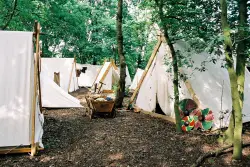 This style base camp is better for groups who pick a remote spot, set up tents/shelters and have a small community. Some even go as far as one big tent for a meeting place and the families then have smaller ones for their homes. The Nomad camp can be erected in little time from start to finish; it takes about two hours to set up and break down.
This style base camp is better for groups who pick a remote spot, set up tents/shelters and have a small community. Some even go as far as one big tent for a meeting place and the families then have smaller ones for their homes. The Nomad camp can be erected in little time from start to finish; it takes about two hours to set up and break down.
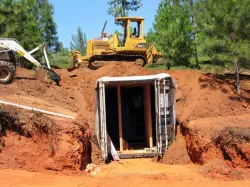 The bunker is harder because you must to have land to make it a permanent shelter that is hidden from everyone but you and your group. It is difficult to build this style of shelter without everyone knowing unless you have land that is far off the beaten path. It can also cost a lot to make and keep up with.
The bunker is harder because you must to have land to make it a permanent shelter that is hidden from everyone but you and your group. It is difficult to build this style of shelter without everyone knowing unless you have land that is far off the beaten path. It can also cost a lot to make and keep up with.
Some people choose this style because it is much easier to hide. The bunker is also the most defensible type of base camp with limited entrances and advantageous positions.
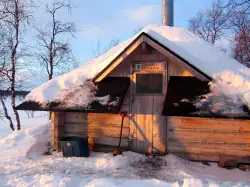 This style base camp is great, once again, if you have land off the beaten path and just want to get out before the SHTF. The permanent base camp may be just like a home with walls and a roof. It’s a lot like a cabin many outdoorsmen have for their hunting trips. Ideally it is not hard to get to, but not right out in the open for the whole world to see either. Overall, it is easier to build, but harder to hide than the bunker.
This style base camp is great, once again, if you have land off the beaten path and just want to get out before the SHTF. The permanent base camp may be just like a home with walls and a roof. It’s a lot like a cabin many outdoorsmen have for their hunting trips. Ideally it is not hard to get to, but not right out in the open for the whole world to see either. Overall, it is easier to build, but harder to hide than the bunker.
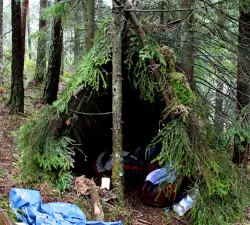 This one is usually found near a survival cache. It’s a spot where all the basics are covered like shelter, weapons, 3 days worth of food, and water gathering materials. You make this camp in preparation of moving to a better more permanent location soon. They are great for those of us that like being able to Bug Out quickly without a second thought.
This one is usually found near a survival cache. It’s a spot where all the basics are covered like shelter, weapons, 3 days worth of food, and water gathering materials. You make this camp in preparation of moving to a better more permanent location soon. They are great for those of us that like being able to Bug Out quickly without a second thought.
Article by Survival Cache contributing author Chuck
1. Nomad
 This style base camp is better for groups who pick a remote spot, set up tents/shelters and have a small community. Some even go as far as one big tent for a meeting place and the families then have smaller ones for their homes. The Nomad camp can be erected in little time from start to finish; it takes about two hours to set up and break down.
This style base camp is better for groups who pick a remote spot, set up tents/shelters and have a small community. Some even go as far as one big tent for a meeting place and the families then have smaller ones for their homes. The Nomad camp can be erected in little time from start to finish; it takes about two hours to set up and break down.Advantages: Speed, Community
Disadvantages: Difficult to defend, Not permanent
2. Bunker
 The bunker is harder because you must to have land to make it a permanent shelter that is hidden from everyone but you and your group. It is difficult to build this style of shelter without everyone knowing unless you have land that is far off the beaten path. It can also cost a lot to make and keep up with.
The bunker is harder because you must to have land to make it a permanent shelter that is hidden from everyone but you and your group. It is difficult to build this style of shelter without everyone knowing unless you have land that is far off the beaten path. It can also cost a lot to make and keep up with.Some people choose this style because it is much easier to hide. The bunker is also the most defensible type of base camp with limited entrances and advantageous positions.
Advantages: Fortified, very Defensible, Can be Hidden
Disadvantages: Difficult to Build, Can be Expensive, Usually need your own land
3. Permanent
 This style base camp is great, once again, if you have land off the beaten path and just want to get out before the SHTF. The permanent base camp may be just like a home with walls and a roof. It’s a lot like a cabin many outdoorsmen have for their hunting trips. Ideally it is not hard to get to, but not right out in the open for the whole world to see either. Overall, it is easier to build, but harder to hide than the bunker.
This style base camp is great, once again, if you have land off the beaten path and just want to get out before the SHTF. The permanent base camp may be just like a home with walls and a roof. It’s a lot like a cabin many outdoorsmen have for their hunting trips. Ideally it is not hard to get to, but not right out in the open for the whole world to see either. Overall, it is easier to build, but harder to hide than the bunker.Advantages: Good protection from the elements, fairly defensible
Disadvantages: Expensive, not easily hidden, need your own land
4. Emergency
 This one is usually found near a survival cache. It’s a spot where all the basics are covered like shelter, weapons, 3 days worth of food, and water gathering materials. You make this camp in preparation of moving to a better more permanent location soon. They are great for those of us that like being able to Bug Out quickly without a second thought.
This one is usually found near a survival cache. It’s a spot where all the basics are covered like shelter, weapons, 3 days worth of food, and water gathering materials. You make this camp in preparation of moving to a better more permanent location soon. They are great for those of us that like being able to Bug Out quickly without a second thought.Advantages: Very quick to set up, easily hidden, cheap,
Disadvantages: temporary, not easily defended, limited supplies
More Types?
I am sure there are other types that I am missing but these are the first few that come to mind when thinking about TEOTWAWKI. If you have any other kinds of survival camps let us know. I am always open to suggestions.Saturday, June 12, 2010
Added Status Code to sidebar
We've added status codes to the sidebar. These are to indicate the current situation of the state. Yellow means keep being ready and alert, but there is no immediate threat. Orange means something may be up so make sure your stuff is in order. Red means emergency. In a code red situation, it's time to go on lockdown or get out.
Wednesday, June 9, 2010
Why the World Needs Survivalists
Episode 94 – Why the world NEEDS survivalists.
By Todays Survival Show on June 3rd, 2010
Some consider survivalists as throwbacks to a lost era. In this episode I will discuss some character traits of survivalists and why I think that we are one of the last hopes this world has, to survive long term. I discuss things like confidence, skill building, relationships, what happens when people loose their “dependency lifeline.”
Highlights:
- Why people are wired for self preservation.
- Survival is instinctive.
- Why people are prejudice against survivalists.
- Why balance in your preparations is critical.
- The anti-gun sentiment.
- How non survivalists put everything they have into a sinking ship.
Summer Survival: Dehydration
from Stealth Survival by (riverwalker)

The effects of dehydration can lead to death during a disaster, a crisis or even a common everyday activity. It doesn’t matter if you are in an outdoor or an urban setting. You can also suffer the effects of dehydration in both hot and cold weather. The lack of sufficient fluid for your body will be devastating in either case. The effects of severe dehydration are quite often fatal. The most disturbing thing is that quite often a little advance planning and a decent knowledge about the effects of dehydration and how to treat it can save a life. Except in cases of severe dehydration, the average person can usually treat minor cases of dehydration until proper medical help can be obtained. Without a doctor present or a hospital which is readily available, everyone needs to learn how to recognize and treat the effects of dehydration.
Signs and Symptoms of Dehydration:
One of the first things you should learn is the signs and symptoms of dehydration. You need to be able to recognize dehydration when it occurs in order to start effective treatment as soon as possible. The signs and symptoms may include any or all of the following:
Thirst
Dark colored urine
Lack of, infrequent urination or an inability to urinate
Muscle cramping
Little or no sweat
Dry mouth or nose
Dry skin that feels tight
Weakness, dizziness or a feeling you may faint
Persons at High Risk for Dehydration:
The next thing about dehydration that everyone should know is that the risk factors are different for individuals depending upon your age, the type of activity you are involved in and your physical condition. Persons at risk include the following:
Infants and small children have a high risk factor and are highly susceptible to the effects of dehydration.
Persons that may have current health problems and are taking medications that may contribute to or cause dehydration.
Elderly persons or those persons with weakened immune systems.
Persons involved in strenuous physical activities.
Persons active in extremely hot or cold environments are also highly susceptible to the effects of dehydration.
Avoiding Dehydration
Another important aspect you should be aware of is the simple things you can do to avoid the effects of dehydration. The best treatment for dehydration is to avoid it if at all possible.
Stay hydrated at all times. Making drinking plenty of water on a frequent basis part of your normal routine.
Drink extra water if you are eating dry or salty foods.
Allow time for a water break when involved in any type of strenuous activity.
Always have plenty of safe drinking water available.
Regularly include fresh fruits and vegetables with a high water content in your diet.
Don’t drink untreated water. Water from ponds, streams, rivers etc. that hasn’t been properly treated will probably cause you to become sick. This may make you even more susceptible to the effects of dehydration.
Treating Dehydration
There are some simple steps to help treat dehydration in minor cases that don’t require immediate medical help. In cases of severe dehydration you should always seek immediate medical attention.
Give individuals showing signs of dehydration small and frequent amounts of water, juice or electrolyte solutions (sports drinks, etc.) until their symptoms get better.
Limit the physical activity of persons exhibiting signs of dehydration.
Treat critical areas of the body such as armpits and groin areas with moist cloths to minimize further dehydration.
Try to minimize the dehydrating effects of environmental conditions by moving the affected person to either a cooler environment, in the case of extremely warm temperatures, or a warmer area, in the case of extremely cold temperatures.
In an emergency situation, you can make an expedient oral rehydration solution by mixing 1/2 teaspoon salt, 1/2 teaspoon baking soda and 3 tablespoons of sugar to a quart of safe drinking water.
Always seek proper medical attention if there is severe dehydration. Extreme dehydration can be fatal if left untreated.
Staying above the water line!
Riverwalker
Constitution Party
from dseelman:
As much as I hate to push politics, I think I found the party for me. Check them out @ http://constitutionpartyny.com/
As much as I hate to push politics, I think I found the party for me. Check them out @ http://constitutionpartyny.com/
"Our mission is to educate the public, cultivate candidates, and get them elected to public office so that they may uphold the principles of the United States Constitution."
When SHTF These items will disappear first:
from http://www.shtfplan.com/emergency-preparedness/when-shtf-these-100-items-will-disappear-first_06032010
Emergency Items That Disappear First
1. Generators (Good ones can be expensive. It can be a target for thieves due to the noise)
2. Water
3. Water Filters/Purifiers
4. Portable Toilet
5. Seasoned Firewood. Wood takes about 6-12 months to be ready for home use.
6. Lamp Oil, Wicks, Lamps (Buy clear oil. If scare, stockpile)
7. Coleman Fuel
8. Charcoal and Lighter fluid
9. Family Protection (guns, ammunition, pepper spray, knives)
10. Cooking utensils (hand can opener, whisk, etc)
11. Honey/sugar/syrups
12. Rice/beans/ wheat
13. Vegetable oil (for cooking)
14. Water containers (get more than one and in different sizes)
15. Propane Heaters and all accessories that go with it (extra propane, heads, etc)
16. Fishing accessories (line, hooks, bobbies, etc)
17. Lighting sources – short term and long term (flashlights, hurricane lamps, etc)
18. Batteries
19. Basin to do laundry in/wash boards, etc
20. Cook stoves
21. Vitamins
22. Thermal underwear (top and bottoms)
23. Tools (bow saw, axes, hatchets, wedges (honing oil)
24. Aluminum Foil
25. Propane Cylinder Handle-Holder (Urgent: Small canister use is dangerous without this item)
26. Feminine Hygiene/Haircare/Skin products.
27. Aluminum Foil Reg. & Heavy Duty (Great Cooking and Barter Item)
28. Gasoline containers
29. Garbage bags
30. Toilet paper, paper towels, hygiene items
31. Milk (canned, powdered and infant formula)
32. Work gloves, Work boots, Work Clothes
33. Seeds (non-hybrid)
34. Clothes pins/line/hangers
35. Coleman’s Pump Repair Kit
36. Canned Goods
37. Fire Extinguishers or Baking Soda
38. First Aid Kits
39. Batteries (all sizes)
40. Spices, Vinegar and Baking Supplies, Yeast, Salt
41. Dog Food
42. Matches
43. Notebooks, pencils
44. Ice chests
45. Flash lights, torches, light sticks
46. Plastic Containers
47. Cast iron cookware
48. Fishing Supplies
49. Repellent sprays, creams
50. Duct Tape
51. Garbage cans Plastic (great for storage, water, transporting – if with wheels)
52. Men’s Hygiene: Shampoo, Toothbrush/paste, Mouthwash/floss, nail clippers, etc
53. Shaving supplies (razors & creams, talc, after shave)
54. Cast iron cookware (sturdy, efficient)
55. Fishing supplies/tools
56. Mosquito coils/repellent, sprays/creams
57. Duct Tape Tarps/stakes/twine/nails/rope/spikes
58. Candles
59. Laundry Detergent (liquid)
60. Backpacks, Duffel Bags
61. Garden tools & supplies
62. Scissors, fabrics & sewing supplies
63. Canned Fruits, Veggies, Soups, stews, etc.
64. Bleach (plain, NOT scented: 4 to 6% sodium hypochlorite)
65. Canning supplies, (Jars/lids/wax)
66. Knives & Sharpening tools: files, stones, steel
67. Bicycles…Tires/tubes/pumps/chains, etc
68. Sleeping Bags & blankets/pillows/mats
69. Carbon Monoxide Alarm (battery powered)
70. d-con Rat poison, MOUSE PRUFE II, Roach Killer
71. Mousetraps, Ant traps & cockroach magnets
72. Paper plates/cups/utensils (stock up, folks)
73. Baby wipes, oils, waterless & Antibacterial soap (saves a lot of water)
74. Rain gear, rubberized boots, etc.
75. Hand pumps & siphons (for water and for fuels)
76. Soy sauce, vinegar, bullions/gravy/soup base
77. Reading glasses
78. Chocolate/Cocoa/Tang/Punch (water enhancers)
79. “Survival-in-a-Can”
80. Woolen clothing, scarves/ear-muffs/mittens
81. Boy Scout Handbook, / also Leaders Catalog
82. Roll-on Window Insulation Kit (MANCO)
83. Graham crackers, saltines, pretzels, Trail mix/Jerky
84. Popcorn, Peanut Butter, Nuts
85. Socks, Underwear, T-shirts, etc. (extras)
86. Lumber (all types)
87. Wagons & carts (for transport to and from)
88. Cots & Inflatable mattress’s
89. Gloves: Work/warming/gardening, etc.
90. Lantern Hangers
91. Screen Patches, glue, nails, screws,, nuts & bolts
92. Teas
93. Coffee
94. Cigarettes
95. Wine/Liquors (for bribes, medicinal, etc,)
96. Paraffin wax
97. Glue, nails, nuts, bolts, screws, etc.
98. Atomizers (for cooling/bathing)
99. Hats & cotton neckerchief
100. Goats/chickens
Emergency Items That Disappear First
1. Generators (Good ones can be expensive. It can be a target for thieves due to the noise)
2. Water
3. Water Filters/Purifiers
4. Portable Toilet
5. Seasoned Firewood. Wood takes about 6-12 months to be ready for home use.
6. Lamp Oil, Wicks, Lamps (Buy clear oil. If scare, stockpile)
7. Coleman Fuel
8. Charcoal and Lighter fluid
9. Family Protection (guns, ammunition, pepper spray, knives)
10. Cooking utensils (hand can opener, whisk, etc)
11. Honey/sugar/syrups
12. Rice/beans/ wheat
13. Vegetable oil (for cooking)
14. Water containers (get more than one and in different sizes)
15. Propane Heaters and all accessories that go with it (extra propane, heads, etc)
16. Fishing accessories (line, hooks, bobbies, etc)
17. Lighting sources – short term and long term (flashlights, hurricane lamps, etc)
18. Batteries
19. Basin to do laundry in/wash boards, etc
20. Cook stoves
21. Vitamins
22. Thermal underwear (top and bottoms)
23. Tools (bow saw, axes, hatchets, wedges (honing oil)
24. Aluminum Foil
25. Propane Cylinder Handle-Holder (Urgent: Small canister use is dangerous without this item)
26. Feminine Hygiene/Haircare/Skin products.
27. Aluminum Foil Reg. & Heavy Duty (Great Cooking and Barter Item)
28. Gasoline containers
29. Garbage bags
30. Toilet paper, paper towels, hygiene items
31. Milk (canned, powdered and infant formula)
32. Work gloves, Work boots, Work Clothes
33. Seeds (non-hybrid)
34. Clothes pins/line/hangers
35. Coleman’s Pump Repair Kit
36. Canned Goods
37. Fire Extinguishers or Baking Soda
38. First Aid Kits
39. Batteries (all sizes)
40. Spices, Vinegar and Baking Supplies, Yeast, Salt
41. Dog Food
42. Matches
43. Notebooks, pencils
44. Ice chests
45. Flash lights, torches, light sticks
46. Plastic Containers
47. Cast iron cookware
48. Fishing Supplies
49. Repellent sprays, creams
50. Duct Tape
51. Garbage cans Plastic (great for storage, water, transporting – if with wheels)
52. Men’s Hygiene: Shampoo, Toothbrush/paste, Mouthwash/floss, nail clippers, etc
53. Shaving supplies (razors & creams, talc, after shave)
54. Cast iron cookware (sturdy, efficient)
55. Fishing supplies/tools
56. Mosquito coils/repellent, sprays/creams
57. Duct Tape Tarps/stakes/twine/nails/rope/spikes
58. Candles
59. Laundry Detergent (liquid)
60. Backpacks, Duffel Bags
61. Garden tools & supplies
62. Scissors, fabrics & sewing supplies
63. Canned Fruits, Veggies, Soups, stews, etc.
64. Bleach (plain, NOT scented: 4 to 6% sodium hypochlorite)
65. Canning supplies, (Jars/lids/wax)
66. Knives & Sharpening tools: files, stones, steel
67. Bicycles…Tires/tubes/pumps/chains, etc
68. Sleeping Bags & blankets/pillows/mats
69. Carbon Monoxide Alarm (battery powered)
70. d-con Rat poison, MOUSE PRUFE II, Roach Killer
71. Mousetraps, Ant traps & cockroach magnets
72. Paper plates/cups/utensils (stock up, folks)
73. Baby wipes, oils, waterless & Antibacterial soap (saves a lot of water)
74. Rain gear, rubberized boots, etc.
75. Hand pumps & siphons (for water and for fuels)
76. Soy sauce, vinegar, bullions/gravy/soup base
77. Reading glasses
78. Chocolate/Cocoa/Tang/Punch (water enhancers)
79. “Survival-in-a-Can”
80. Woolen clothing, scarves/ear-muffs/mittens
81. Boy Scout Handbook, / also Leaders Catalog
82. Roll-on Window Insulation Kit (MANCO)
83. Graham crackers, saltines, pretzels, Trail mix/Jerky
84. Popcorn, Peanut Butter, Nuts
85. Socks, Underwear, T-shirts, etc. (extras)
86. Lumber (all types)
87. Wagons & carts (for transport to and from)
88. Cots & Inflatable mattress’s
89. Gloves: Work/warming/gardening, etc.
90. Lantern Hangers
91. Screen Patches, glue, nails, screws,, nuts & bolts
92. Teas
93. Coffee
94. Cigarettes
95. Wine/Liquors (for bribes, medicinal, etc,)
96. Paraffin wax
97. Glue, nails, nuts, bolts, screws, etc.
98. Atomizers (for cooling/bathing)
99. Hats & cotton neckerchief
100. Goats/chickens
Sunday, June 6, 2010
Thursday, June 3, 2010
Bug Out Survival
"I just received my copy of this book. Looks Great." -dseelman
Bug Out Survival is a prepardness blog by
Scott B. Williams, author of the new book:
Bug Out: The Complete Plan for Escaping a Catastrophic Disaster Before It's Too Late.Ulysses Press, May 2010
A.N.T.S.
from dseelman:
I've recently come across this. What do you think?
http://americansnetworkingtosurvive.org/
I've recently come across this. What do you think?
http://americansnetworkingtosurvive.org/
Wednesday, June 2, 2010
Appleseed Project
In case you haven't heard of this yet:
The Appleseed Program is designed to take you from being a simple rifle owner to being a true rifleman. An American tradition, the rifleman has been defined as a marksman capable of hitting a man-sized target from 500 yards away - no ifs, ands or buts about it. This 500-yard range is traditionally known as "the rifleman's quarter-mile." A rifleman can hit just about any target he can see within that radius. Marksmanship skill (albeit with smoothbore muskets) was particularly evident in the birth of our country, and was the difference in winning the Revolutionary War, right from the first day.
Homepage: http://appleseedinfo.org/
View Project Appleseed Schedule in a larger map
The Appleseed Program is designed to take you from being a simple rifle owner to being a true rifleman. An American tradition, the rifleman has been defined as a marksman capable of hitting a man-sized target from 500 yards away - no ifs, ands or buts about it. This 500-yard range is traditionally known as "the rifleman's quarter-mile." A rifleman can hit just about any target he can see within that radius. Marksmanship skill (albeit with smoothbore muskets) was particularly evident in the birth of our country, and was the difference in winning the Revolutionary War, right from the first day.
Homepage: http://appleseedinfo.org/
View Project Appleseed Schedule in a larger map
Subscribe to:
Posts (Atom)

